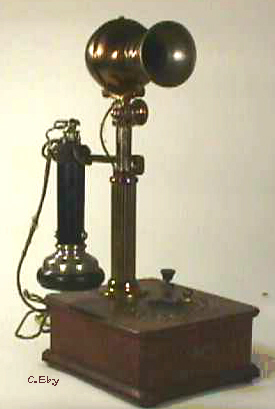 WILHELM
CANDLESTICK
WILHELM
CANDLESTICK WILHELM
CANDLESTICK
WILHELM
CANDLESTICK
During the years of 1894 and 1895, Walter Wilhelm, an electrician, experimented with telephone transmitters. This lead to the Double Diaphragm which is a trademark of the Wilhelm telephones. The unique transmitter was assigned the Canadian patent number 51,649 on March 13, 1896 and the U.S. Patent number 557,741 on April 7, 1896.
Most Wilhelm telephones are like other phones with the exception
of the transmitter which contains two separate chambers and diaphragms.
Sound waves strike on both sides of the same electrode after traveling
through two tubes which branch from a single mouthpiece.
The transmitter is easily recognizable being about the size of
a baseball with the mouthpiece measuring 21/2 " in diameter.
The Wilhelm Telephone Mfg. company of Buffalo, New York was formed
in November 1898 and tried several times to sell its transmitter
to the Bell System. The Bell System tested the transmitter
but decided that it would not suit their purpose. By 1913
the company ceased operations.
The instrument as shown is a ten line candlestick. The
oak base measures 6"wide by 7"deep by 2 1/2 " high.
The entire phone stands 14" tall. The ornate fluted
shaft, stem, hook and transmitter is made of nickeled brass.
At the rear of the base, a small brass cup, when removed, reveals
a buzzer. Although Wilhelm phones were furnished with Bi-polar
Ericsson receivers, this instrument has a solid receiver.
Return to the Main Page